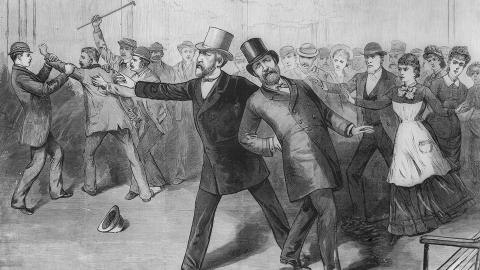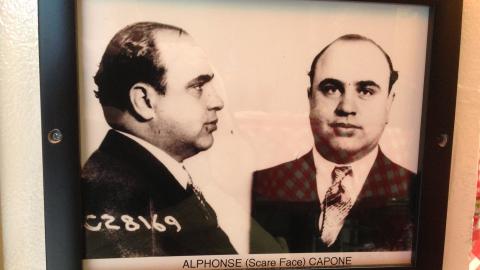
Mountain Men features a variety of men from Appalachia, the Rocky Mountains and Alaska. In season 12, winter in the North American wilderness cannot be conquered. At best, it is endured and only by those who will fight tooth and nail for the privilege of survival. Young bloods and old hands alike must earn their wild existence against the worst odds that nature can stack against them.
The new season starts Thursday, 30th November at 9pm on Sky HISTORY.
On Mountain Men we learn about the lives of the men that live out in the wilderness, off the grid, and that make a living independently and by their own rules. These mavericks stem from a long succession of mountain men - dating all the way back to the original American pioneers.
Find out about some of America's most famous historical mountain men:
1. John Colter
John Colter was part of the Lewis and Clark Expedition. Commissioned by President Thomas Jefferson, it was the first expedition to explore the western parts of the USA. Departing in 1804, Colter joined a select group of paid volunteers and for two years explored the west. While many of his team members were happy to return to the East Coast once the expedition was complete, Colter decided to stay out in the west, and earn his way as a trapper.
Ever the explorer, he became one of the first known white man to enter what is now known at Yellowstone National Park and the Teton Mountain Range. A mountain peak, Colter Peak, has been named after him in Yellowstone and he is widely regarded as America's first known mountain man.
2. Jim Bridger
One of history's most infamous mountain men, Jim Bridger explored and worked across the Western states of America between 1820-1850. Joining the Rocky Mountain Fur Company at the age of 18 at the Missouri River, he became an animal trapper by trade, and his explorations allowed him to establish new frontier routes and he is believed to be the very first white man to see Great Salt Lake in Utah.
Described by one historian as a "walking atlas," his life's exploits include marrying a total of three Native American women, surviving a bow and arrow wound, reinventing himself from trapper to a successful trader and learning to speak several Native American languages. Portrayed many times in film and television, his character was most recently played by Will Poulter in the 2015 hit film The Revenant.
3. Kit Carson
A frontier legend within his own lifetime, Kit Carson had various careers including trapper, wilderness guide, Indian Agent (a translator and liasor between Native Americans and the U.S. Government) and an Army officer. Born in 1809, Kit left home in his late teens (in what is now modern day Missouri) and became a mountain man, working his way across the rough terrains of the western states and earning a living as a fur trapper. Then a chance meeting with famed explorer John C. Fremont in 1842 led him to be hired as a wilderness guide for Fremont's western expeditions.
Popularised by the era's tabloids and dime novels, Fremont and Carson were soon American celebrities. Based on Fremont's published reports, their adventures and trials were widely publicised and fictionalised. He would go on to serve in both the Mexican-American war and the Civil War, and advocated for Native American reservations to be created. He married three times and fathered ten children.
4. Jedediah Smith
Jedediah lived a short yet action packed life. Originally from New York, he joined a fur trapping company in his early 20's and was hired to find new routes and areas to trap otter and beaver in Wyoming and the Dakotas, he helped discover the South Pass. This is the term used to describe two mountain passes for the Continental Divide, which would then become essential routes for trappers, traders and for the gold rush.
However, his journeys were not without drama, as many a time he and his men were ambushed by Native Americans and he was even attacked by a grizzly bear. His scalp and face were so badly mauled that he wore long hair up to his death in an attempt to hide his scars. In 1830 Jedediah decided to retire from trapping and become a trader, but on a trading journey was attacked and killed by Comanche Indians. He was 32 years old.
5. James Beckwourth
Born either in 1798 or 1800 James was born into slavery, his mother a slave and his father her slave master. Acknowledged and accepted as his son, his father freed James in the early 1820's and he then entered the fur trapping industry. He quickly gained prominence as an explorer and fur trapper in the Rocky Mountains and his tales of fighting off Native American tribes and bears became widespread and notorious. He would then integrate himself into the Crow Native American tribe, married one of the Chief's daughters and supposedly had multiple other Native American wives.
He continued to make a living as a trapper but would live with the tribe for nine years. He rose to the role of Chief and was appointed leader of the "Dog Clan," but in the 1830's returned to St. Louis and took on the roles of courier in Florida’s Seminole Wars, trader and gambler and eventually a wilderness guide. He helped establish the trading post that is now known as the town of Pueblo in Colorado and discovered a route through the Sierra Nevada Mountains.
6. Joseph Walker
Born in 1798, Joseph Walker led the life of a true explorer and is believed to be the first white man to ever enter what is now known as Yosemite National Park. He first began to explore the west in the 1820's as an illegal fur trapper and would then become the wilderness guide for future famed explorers John C. Fremont and Benjamin Bonneville.
When working for Bonneville he led an expedition across the Sierra Nevada and although they were met with extreme physical hardship (they were forced to eat their horses to survive), they eventually made it to Yosemite, which inspired Walker to such an extent that his tombstone is engraved with "camped at Yosemite." He would go on to be a trader and ranch owner, and even led a successful gold-hunting expedition in Arizona and subsequently had the town Walker in Arizona named after him.

















